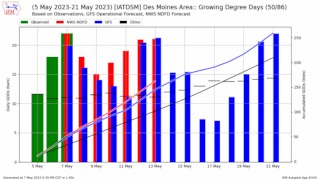
Figure 1. GDD accumulation estimates on May 5 planted soybean based on two weather forecasts for Des Moines, IA. Source: Iowa Environmental Mesonet Autoplot #240, Daryl Herzmann.
If your planter got too far ahead of the sprayer and you’ll miss the window for your PRE application, alternative options exist to avoid damaging soybean seedlings and provide good weed control. Farmers may choose to switch the above active ingredients to a Group 15-based program with metolachlor (metolachlor), acetochlor (Warrant), dimethenamid (Outlook), pyroxasulfone (Zidua), or mixtures containing Group 14 active ingredient fomesafen (like Prefix) for waterhemp control.
Products containing fomesafen, 2,4-D, dicamba, or glufosinate (Liberty) will be effective in tank mixes if waterhemp has emerged prior to application, and the appropriate choice depends on numerous factors including weather conditions, plant size, and crop tolerance. Numerous Group 2 herbicides are also labeled for early POST. While Group 2 herbicides are ineffective for waterhemp control, they can improve the spectrum of control for other species (particularly large-seeded ones) like common cocklebur, velvetleaf, and giant ragweed.
While the rainfall was beneficial for everyone, get the season off to a great start by making sure your herbicide applications won’t set your soybeans back. Reach out to your Iowa State University Extension and Outreach field agronomist for local recommendations.
Source : iastate.edu